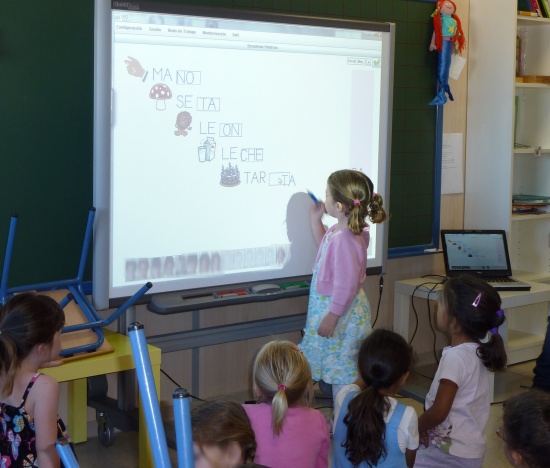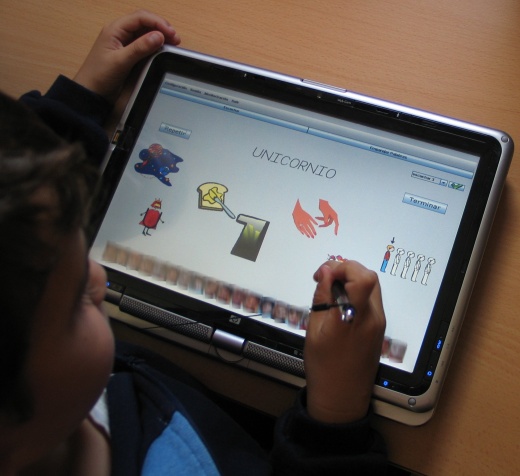Leo
From PatioWiki
(→Evaluation mode) |
|||
| Line 15: | Line 15: | ||
[[File:Menu_Op_Sesion_LEO.png]]<br /><br /> | [[File:Menu_Op_Sesion_LEO.png]]<br /><br /> | ||
In the dialog box you can see that there are three options to choose from:<br /> | In the dialog box you can see that there are three options to choose from:<br /> | ||
| - | + | # '''Class''': this option will indicate the particular class with which you will work (4A, 4B, 4C, 5A ...). When loading any exercise, you will see a mosaic of photos of students of selected class. | |
| - | + | # '''Mode''': with this option you will selecte the mode or scenario with which to work on. You can select between Single, Group, or All. | |
| - | + | # '''Position of students''': this parameter specifies the location of the screen (top or bottom) which will be shown, during the exercises, the mosaic with the photos of students. | |
Revision as of 08:53, 4 October 2010
LEO is a system that supports and strengthens the teaching tasks of the educator in the field of literacy with preschool children between 4 and 5 years in a multicultural setting. It is based on the phonetic method of "Letrilandia" (Usero, 2004).
It allows the teacher to create exercises of different types (letters, syllables, words and phrases) quickly and easily. It has two working modes: learning mode and evaluation mode, with which students can learn in a group or be tested individually, respectively.
The system is equipped with a multitude of multimedia resources (audio, video, graphics, voice, drawings, blackboard, etc..) and it can run in numerous technological media (computer, Tablet-PC or touch screen).
The system includes two main roles: teacher and student.
Teacher
The following diagram shows the different actions that a teacher can do.

Configure session options
The work session is characterized with the configuration of certain parameters such as class, mode and position of students. These parameters must be specified before starting the work session and if not, el system will display a message advising configure the session and refuse to start working anyway.
To access the screen that you configure session options is necessary to click on the toolbar above the menu Session.

After that, it displays the dialog box with which you configure session options.
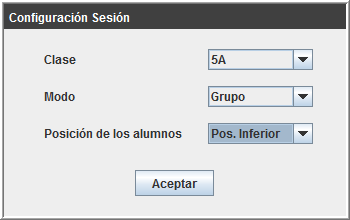
In the dialog box you can see that there are three options to choose from:
- Class: this option will indicate the particular class with which you will work (4A, 4B, 4C, 5A ...). When loading any exercise, you will see a mosaic of photos of students of selected class.
- Mode: with this option you will selecte the mode or scenario with which to work on. You can select between Single, Group, or All.
- Position of students: this parameter specifies the location of the screen (top or bottom) which will be shown, during the exercises, the mosaic with the photos of students.
Create activities
To create an exercise you have to go to the menu Settings in the toolbar and click on the option Activities>> New activity.

Next, is shown a new window with which you can choose the type of activity to be created.

After selecting the type of activity, will be charged on display a new window through which you can specify the features options of each type of activity. These windows are different from each other depending on the type of exercise you choose although they have several fields in common. Then, will describe the process for creating each of these exercises.
Crear Ejercicio Comprensión de Palabras
Crear Ejercicio Construye Palabras
Crear Ejercicio Emparejar Palabras
Crear Ejercicio Encadenar Palabras
Crear Ejercicio Escribir
Crear Ejercicio Escuchar
Crear Ejercicio Nube de Letras
Crear Ejercicio Ordenar Frase
Delete activities
Similar to the previous case, to delete an existing exercise you must go to the settings menu of the toolbar and click on the option Activities >> Delete activity.

Next, is shown a new window where you can select the type of activity you want to delete.

After selecting the desired type of exercise, will be charged a new window. It will show all the existing exercises in the system and belong to the type of activity selected in the previous screen.
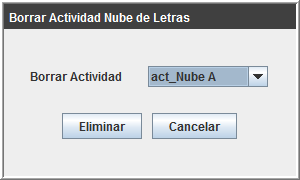
When you have chosen the name of the exercise you want to delete and click on the button Delete, will appear several messages for that the user confirm the action you are about to perform.
Create evaluation session
An evaluation session is formed by a serie of sets of predetermined exercises, such sets will be assigned to the students you want. These will be presented to the student for do alone and independently.
To create an evaluation session must go to the menu Settings in the toolbar and click on the option Session Evaluation >> New Session.

To create a evaluation session is necessary to perform the following two steps:
- Assign sets of exercises to the pupils that you want.
- Establish for each pupil, the order in which exercises of each group will be showing.
Assignment of exercises to pupils
The interface that the teacher has to perform this step is the following:
//Captura de la ventana del editor de sesiones de evaluacion//
The teacher should assign an identifying name to the session. He also needs to specify whether the session is active or not, that is, if you want that the session that you're creating is available for that the students perform it.
The window has two data filters through which the teacher can work more comfortably and handle only information that is useful:
- Class: The teacher should choose the class (4A, 4B ,..., 5C) with which he wants to work. By selecting one of them will be loaded a list with photo and name of pupils who belong to that class.
- Type of activity: the teacher can choose the types of activities with which he wants to work. By selecting the desired types will display a list of exercises belonging to the selected types available in LEO.
To make the assignment of exercises to pupils, only the teacher should click on the pupils of the list that he wants and then select which exercises that he wants pupils perform it. If the teacher wants to assign to a group of pupils the same set of exercises will not have to make an assignment for each pupils, but can simply make the assignment once because the system can assign exercises both to a single pupil as to a selected group.
The window also has several points of information, through which summarizes the assignments that have been made:
- Pupil information: next to each pupil of the list there is a button that when is pressed will display a screen with a summary of the exercises that have been assigned to that pupil.
- Exercise information: next to each exercise of the list there is a button that when is pressed displays a window that lists all the pupils who has been assigned this exercise.
//captura venetana información alumno// //captura venetana información ejercicio//
Finally, in the bottom of the screen there are three control buttons:
- Sequence Button: When you click on this button will go to the 2nd step of creating of an evaluation session. Make sequencing is optional. If not done, the exercises will take the default order that corresponds to the order in which they are assigned to pupils.
- Accept Button: clicking this button, the system stores the session that being created. If in this window, you click on this button, you accept the default order of the exercises.
- Cancel Button: Pressing this button cancels the creation of the evaluation session.
Establish order in the exercises
This step in the creation of an evaluation session is optional. If not done, the exercises will take the default order that corresponds to the order in which they are assigned to pupils.
The teacher has the following window to order the exercises:
//Captura del secuenciador de ejercicios//
As can be seen, on the left side of the screen displayed only the pupils who have been assigned some exercise. Clicking on any of them, loaded in the right side of the screen a list with the assigned exercises to that pupil. The shown exercises have the default order. By the arrows shown on the right margin of the screen you can specify the desired order of the exercises.
Finally, in the bottom of the screen there are two control buttons:
- Accept Button: clicking this button, the system will save the session that is being created with the sequences of exercises that has been specified.
- Cancel Button: Pressing this button cancels the creation of the evaluation session.
Delete evaluation session
To delete an existing evaluation session must go to the menu Settings in the toolbar and click on the option Session Evaluation >> Session Delete.

Next, a new window will display all evaluation sessions stored in the system.

When you have select the name of the evaluation session you want to delete and click on the Delete button, several messages will appear for that the user confirm the action you are about to perform.
Select work mode
To select the mode you want to work you must go to the menu work mode from the toolbar and choose one of two available modes in the system.

These two modes are Learning Mode and Evaluation Mode and differ in the way that the exercises are presented to students and work scenario that conducive.
- Learning mode: the use of this mode is designed for that all students of one class perform the exercises in a joint way namely, a student completes the exercise with the presence of their classmates and in this way, all students learn at the same time although only one student do the exercise. To achieve this environment is necessary to use a Smart Board as show in the image on the left.
- Evaluation mode: with this mode is intended to test the knowledge that the student has acquired during the learning sessions. The ideal work scenario for this mode is where the student do the exercises alone, without the presence of any classmate. For this mode, it has been thought to use as support a Tablet-PC as shown in the image on the right.
Learning mode
By selecting the learning mode, a new window will be shown through which you will choose the group of activities with which you want to work. These groups are distinguished by the linguistic unit with which you will work (letters, letters-words, syllables-words, words, words-sentences).

Depending on the choice made, the system will give the possibility to practice with certain types of activities. The following summary shows the available activity types depending by the selected option.
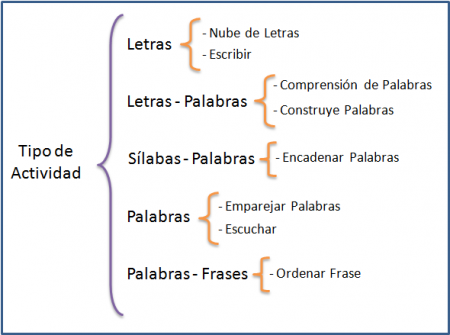
Evaluation mode
When selecting this mode, you must navigate through different screens:
- Start.
- Login.
- Sessions.
- Viewer exercises.
Start screen
This is the first screen that appears after selecting the evaluation mode and looks like this:
// Captura pantalla Incio modo evaluacion //
Using this screen, you can select the class (4A, 4B...5C) with which you work. Once chosen, click on the Accept button to go to the login screen. If you click on Cancel will leave the evaluation mode.
This screen will appear again when a pupil finished making your evaluation session.
Login screen
Through this screen, you can select the student with which you want to perform the evaluation session. The appearance of this screen is:
// Captura pantalla Identificación modo evaluacion //
As can be seen in the image, it shows the photo of each pupil of the selected class in the start screen. These photos may appear of two different ways:
- In colour: it will mean that these pupils have at least one allocated evaluation session. Clicking on any of them, automatically pass to the next screen (screen session).
- Black and white: this means that such pupils haven't got assigned any evaluation session. Clicking on any of them, the system gives the opportunity to create at that time an evaluation session and assign it to the selected pupil.
Screen of sessions
The appearance shown in this screen is as follows:
//Captura pantalla sesiones//
This screen shows a list of all sessions that were assigned to the selected pupils in the previous screen. These sessions appear ordered by date of creation, newest to oldest. Note also that there is a color code to distinguish at a glance the different states in which a session can be.
- Green: the green colour means that the pupil hasn’t yet realized any of the exercises that constitute the session.
- Orange: the orange colour means that the pupil has made some of the exercises that contains the evaluation session, but it hasn't been finished completely. If you select a session in this state, the pupil will continue for the first exercise of the session that has not yet done.
- Gray: the gray colour means that the pupil has completed all the exercises that make up the session. The start of these sessions is disabled.
- Red: the red colour means that the session isn't active, that is, it isn't available to be done by any pupil.
You can choose which is the evaluation session that you want that the pupil does, simply clicking on the arrow next to each session. Pressing, automatically pass to the next screen, the viewer exercises.
Viewer exercises
The viewer of exercise is going to be responsible for presenting the pupil each exercise of the selected evaluation session. Here is an example that shows how the viewer shows the exercise in evaluation mode:
//Captura visor de ejercicios//
After completion of each exercise, the arrow in the lower right corner of the screen is enabled. Clicking on this arrow will be loaded the following exercise that the pupil must perform.
After completion all exercises of the evaluation session, you return to the start screen.
Student
Next, the following diagram shows the actions that a student can do in the system.
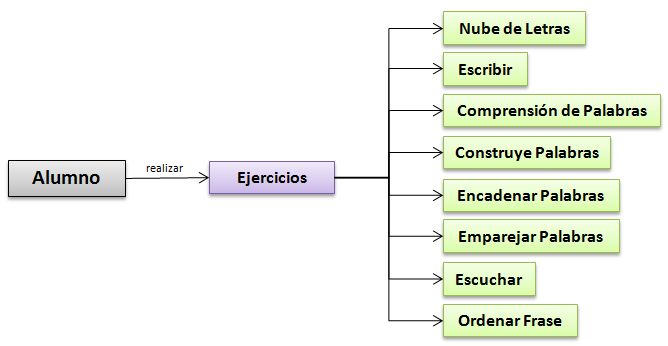
Do exercises
In this section, we describe the main components of the different types of activities and the target of each of them. Depending to the working mode (Learning or Evaluation) in which exercises are performed, the appearance of the interface may vary slightly (some elements disappear) so that the exercises are described for learning mode as this is the way that exercise is shown in its entirety.
